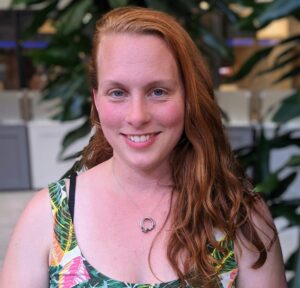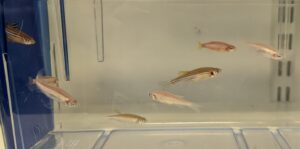Advocating for Animals in Research: talking with Charli Corcoran about her work in the Zebrafish Facility
As a PhD student on the MRC HGU rotation programme I’ve had the opportunity to work in the Zebrafish Facility during one of my rotations. I was very warmly welcomed into the facility and the whole team were always happy to answer questions and provide support. Their enthusiasm was infectious and I found myself really enjoying my time in the facility, learning about the fish alongside getting to know the scientists who look after them.
Charli Corcoran is a Zebrafish Facility Technician in the MRC Human Genetics Unit at the Institute of Genetics and Cancer, who kindly agreed to answer a few of my questions about her career, working with the fish, and the public outreach the Zebrafish Facility engages in.

Charli Corcoran
What is your role at the IGC?
To look after the welfare of the fish used in research and assist the users who are working with fish.
What brought you to the Zebrafish team at the MRC HGU?
I began my career as an Aquarist at Loch Lomond Sea Life Centre, and then at Deep Sea World, where I was responsible for the welfare of many different aquatic species, including sharks, seahorses and seals. I was at Deep Sea World for almost 3 years when my husband’s PhD funding came to an end and the company who sponsored him had a hiring freeze. It was then time to get a real grown up job that paid enough to cover our mortgage. Luckily, the aquatic facility at the QMRI was looking for a Zebrafish Technician, and I was happy to take on the challenge of fish husbandry in a research environment. I worked at the QMRI for a couple of years before taking a career break to care for my young children.
I joined the team here at the IGC in 2018.
It’s good to be an advocate for the fish and that theme has run through all the jobs I’ve had.
What does a typical day in the zebrafish facility look like ?
One of my favourite things about this role is how different every day is, right down to my start time, which is heavily dependent on how cooperative my children and the traffic are. I’m lucky that I can’t start work before 9am, as that’s when the lights go on in the fish rooms. The fish lay their eggs as the sun rises (or in our case, as the lights turn on) so any disturbance before then can effect ongoing experiments. We start the day by checking on the three rooms of fish, to make sure that everything is okay. We check the parameters of the water, pH, temperature and salinity and make any adjustments necessary to make sure that the fish are happy. There are a team of 3 of us and we have slightly different roles through the day. Mornings usually consist of a breakfast of brine shrimp for the fish, a check to make sure that the fish are healthy and that there are no issues with any of the tanks of fish and some equipment maintenance. I try to do the equipment maintenance as early in the day as possible to leave plenty of time to monitor the changes before going home for the day, but that’s not always possible. Some of the maintenance tasks are small and routine, like the filter changes and the probe calibrations, but some of it, like cleaning the sumps and the pipes are more involved. Sometimes we have larger, one off tasks to do like shipping embryos to Europe, which can take the best part of a week to organise.
After the facility staff have had lunch, the fish get another feed, this time dry food. This is the time that I try to use to do any tasks that facility users have requested – like collecting eggs that were laid that morning, preparing the egg collection trays for that evening, moving the baby fish into or out of the nursery, or helping to fin clip the fish in preparation for genotyping. We keep the facility clean and tidy, and stocked up with lab consumables, we keep the facility users up to date with the health of their fish, if I have time I do a like and share a few things on the Technician Steering Committee’s twitter page. Before we leave, we check that all the tanks have water flowing to them, we make sure that the embryos are all where they are supposed to be and not off on adventures in the imaging facility and we double check all the equipment before leaving for the night.
Cameron also wrote a great blog post detailing a typical day in the life of a fish, you can read it on the IGC blog: A day in the life of a fish in research.

Zebrafish (Photo credit: Cameron Wyatt)
How can the zebrafish team support researchers that are interested in working with zebrafish models?
We can support potential users right from the very first step, by training you to work with the fish and help support you to get a licence. The process is different for everyone looking to work with fish in their research and so it’s tailored to what each person needs. We can be as hands on or as hands off as you want.
You can find more information on our website where potential users can find a list of how we can support them, what tasks we do and what tasks we can do if the users require support.
(Visit the Zebrafish facility page on the Institute of Genetics and Cancer website)

Left to right: Charli, Cameron, Jonathan (Photo credit: Maverick Photo Agency)
The zebrafish team recently won the community engagement award at the CMVM staff recognition awards, you’ve also personally won the favourite scientist award for the I’m a Scientist, Get me out of here Genetics Zone. How important is it to communicate what you do?
It’s really important to communicate what you do in all areas of science but especially when working with animals. It is crucial to be open and clear about how and why we use animals in research and to draw attention to the 3R’s: Replacement, Reduction, Refinement.
While I was doing my first rotation and working in the zebrafish facility, you were hosting two S5 students for work experience and gave them a really lovely introduction to what you do. This highlights another type of engagement that people can take part in to communicate the science taking place at the IGC and it also
highlights the importance of mentorship. Do you enjoy mentoring?
Yes, I do. I haven’t had much experience with it but it was great to have work experience students in the facility and to show them what we do. It also gives them a point of contact for any questions they have during their future studies in science.
It’s something I’d love to do more of, if possible. They also baked some lovely cakes!
What are the benefits of communicating your science with the public?
The main benefit is to get people thinking about why we use animals in research and what we do with them in a different context to what they hear on the news and on social media.
You’re a great science communicator, do you feel that talking about your work has informed how you work?
I think it has subconsciously, while I’m working I think more about how I would communicate what I am doing. It may not change what I’m doing, but it does impact how I think of it.
Do you have any advice or tips for people in the IGC that want to get involved with public engagement?
Talk to Dee Davison and Cherry Ferrier and go on the courses they offer, the courses are good for taking that initial step and figuring out how to get started. It is a safe place to try and see if you enjoy public engagement. If you’re not sure if it is for you, you can take the step and find out, there’s no pressure.
As a technician, you play a vital role in a lot of different research at the IGC. Do you feel your work is recognised and appreciated?
On a personal level, I think that the recognition for the work we do in the facility is great. The users verbally acknowledge us all the time, there’s a very friendly atmosphere in the facility and I’ve never felt that what we do is taken for granted. In terms of professional recognition, most of the work that I do is general husbandry and welfare, which are usually included in the acknowledgment section of papers and presentations.
After a day of looking after the fish, what do you do to unwind?
I have three children, so when I get home it is dinner and then bedtime. But to unwind I like to sew and I make clothes. I also enjoy running.
Thank you Charli for taking the time to talk to me, I really enjoyed my time working with you and all of the Zebrafish Facility team.



